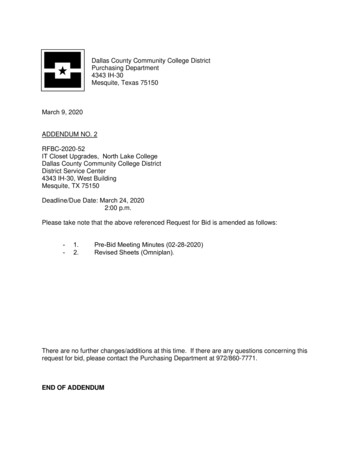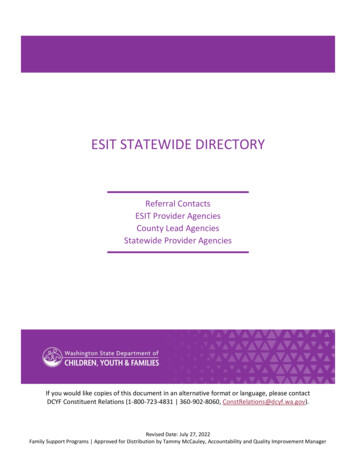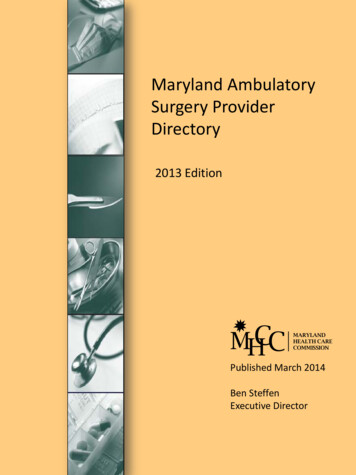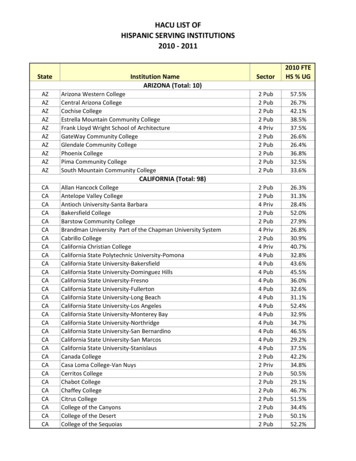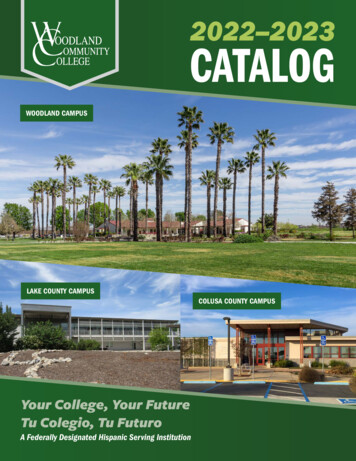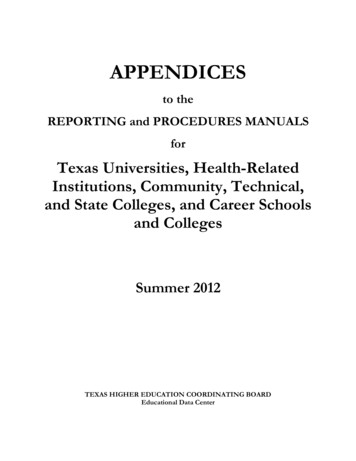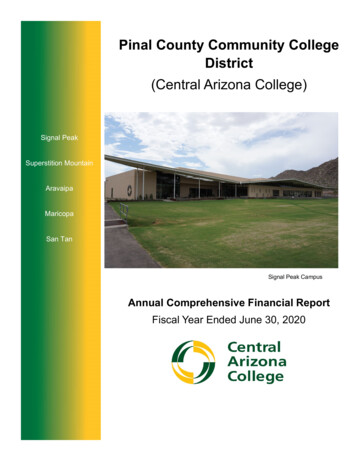
Transcription
Pinal County Community CollegeDistrict(Central Arizona College)Signal PeakSuperstition MountainAravaipaMaricopaSan TanSignal Peak CampusAnnual Comprehensive Financial ReportFiscal Year Ended June 30, 2020
Pinal County Community College District(Central Arizona College)Annual Comprehensive Financial ReportFiscal Year Ended June 30, 2020Prepared by the Business Affairs DepartmentChris Wodka, VP Business Affairs
This Page Intentionally Left Blank
Pinal County Community College District(Central Arizona College)Annual Comprehensive Financial ReportFiscal Year Ended June 30, 2020Table of ContentsINTRODUCTORY SECTIONLetter of TransmittalList of Principal OfficersOrganizational ChartFINANCIAL SECTIONIndependent Auditors’ ReportRequired Supplementary Information — Management’s Discussion and AnalysisBasic Financial StatementsStatement of Net Position — Primary GovernmentStatement of Financial Position — Component UnitStatement of Revenues, Expenses, and Changes in Net Position — PrimaryGovernmentStatement of Activities — Component UnitStatement of Cash Flows — Primary GovernmentNotes to Financial StatementsOther Required Supplementary InformationSchedule of the District’s Proportionate Share of the Net Pension LiabilitySchedule of District Pension ContributionsSTATISTICAL SECTIONNarrative to the Statistical SectionFinancial TrendsNet Position by ComponentChanges in Net PositionStatutory Limit to Budgeted ExpendituresRevenue CapacityProperty Tax Levies and CollectionsPinal County Assessed Value and Estimated Actual Value of Taxable PropertyDirect and Overlapping Property Tax RatesPinal County Direct Property Tax RatesAssessed Valuation, Tax Rate and Levy HistoryPrincipal Property Taxpayers for Pinal CountyDebt CapacityRatios of Outstanding Debt by TypeRatio of Net General Obligation Bonded Debt to Assessed Value and NetGeneral Bonded Debt Per CapitaRatio of Annual Debt Service Expenditures to Operating Expenses/ExpendituresRatio of Pledged Revenue Obligations to Annual Debt Service ExpendituresLegal Debt Margin 67686970717273
Pinal County Community College District(Central Arizona College)Annual Comprehensive Financial ReportFiscal Year Ended June 30, 2020Demographic and Economic InformationPrincipal Employers for Pinal CountyPinal County Demographic and Economic StatisticsEconomic Indicators for Pinal CountyMiscellaneous Statistics for Pinal CountyOperating InformationStudent Enrollment, Degree and Demographic StatisticsHistoric EnrollmentFaculty and Staff StatisticsCapital Asset InformationTuition Schedule747576777879808182
Introductory Section
April 25, 2022The District Governing Board of Pinal County Community College District:The Annual Comprehensive Financial Report of the Pinal County Community CollegeDistrict (the “District”), for the fiscal year ended June 30, 2020, is submitted herewith.Responsibility for both the accuracy of the presented data and the completeness andfairness of the presentation including all disclosures, rests with the District. To the best ofour knowledge and belief, the enclosed data is accurate in all material respects and arereported in a manner designed to present fairly the financial position and results ofoperations of the District. All disclosures necessary to enable the reader to gain anunderstanding of the District’s financial activities have been included. Please read themanagement’s discussion and analysis in conjunction with the Vice President of BusinessAffairs and Executive Director II, Accounting Services/Comptroller’s transmittal letter.This report is prepared in accordance with U.S. generally accepted accounting principles(GAAP) as prescribed by the Government Accounting Standards Board (GASB) using theguidelines as recommended by the Government Finance Officers Association of the UnitedStates and Canada (GFOA).Management is responsible for establishing and maintaining internal controls designed toensure that assets are protected from loss, theft, or misuse, and to ensure that adequateaccounting data is compiled to allow for the preparation of financial statements in conformitywith GAAP. Because the cost of a control should not exceed the benefits to be derived,the objective is to provide reasonable, rather than absolute assurance, that the financialstatements are free of any material misstatements.The District is required to undergo an annual audit. Audit services are provided to theDistrict by the Arizona Auditor General. For the year ended June 30, 2020, the ArizonaAuditor General has issued an unmodified opinion of the District’s financial statements.The independent auditors’ report is displayed in the front of the financial section of thesestatements.1
The Reporting EntityThe District is an independent reporting entity within the criteria established by the GASB.According to GASB Statement No. 14, the financial reporting entity consists of “a primarygovernment, organizations for which the primary government is financially accountable,and other organizations for which the nature and significance of their relationship with theprimary government are such that exclusion would cause the reporting entity’s financialstatements to be misleading or incomplete.” The District is a primary governmentbecause it is a special–purpose government that has a separately elected governingbody, is legally separate, and is fiscally independent of other state and local governments.Although the District shares the same geographic boundaries with Pinal County, financialaccountability for all activities related to public community college education in PinalCounty is exercised solely by the District. In accordance with GASB Statement No. 39,the financial activity of the Central Arizona College Foundation is presented as acomponent unit of the District. The District is not included in any other governmentalfinancial reporting entity.HistoryThe District was established in 1961, when the Arizona Legislature passed a billpermitting counties with the necessary assessed valuation and potential numbers ofstudents to form junior college districts. Groundbreaking ceremonies were held at SignalPeak on Nov. 8, 1968 and Central Arizona College opened its doors in the fall of 1969near the base of Signal Peak Mountain.The District began extending its accessibility throughout Pinal County, becoming animportant community-building entity that still exists today.For 50 plus years now, the District has been serving and educating the diversecommunities of Pinal County. With a total of five campuses and three centers locatedstrategically throughout the county, the District provides accessible, educational,economic, cultural, and personal growth opportunities for those of all ages.Service AreaPinal County was formed from portions of Maricopa and Pima counties on Feb. 1, 1875,in response to the petition of residents of the upper Gila River Valley, as Act #1 of theEighth Territorial Legislature. Florence, established in 1866, was designated and hasremained the county seat.The county encompasses 5,374 square miles, of which 4.5 are water. In both economyand geography, Pinal County has two distinct regions. The eastern portion ischaracterized by mountains with elevations to 6,000 feet and copper mining. The westernarea is primarily low desert valleys and irrigated agriculture.The county is home to many interesting attractions, including the Old West Highway 60,Casa Grande Ruins National Monument, Picacho Peak State Park, Picacho Reservoir,2
Boyce Thompson Southwestern Arboretum, Oracle State Park and Columbia University'sBiosphere II, McFarland State Park, Lost Dutchman State Park, Skydive Arizona, theworld’s largest skydiving drop-zone, and the Florence Historical District, with 120buildings on the National Register.Economic OutlookPrior to the Coronavirus Pandemic impacting Arizona, the Office of Economic Opportunitywithin the Arizona Department of Administration projected Arizona’s economy to growsteadily for the calendar years of 2019-2021. As of December 2020, Arizona’sunemployment rate was 8%. According to data released, in November 2021, by theUniversity of Arizona Economic and Business Research Center, Arizona job recoveryslowed in August and September of 2021 although was close to the pre-pandemic high.Inflation and supply chain shortages are expected to ease as more return to the jobmarket in 2022.U.S. Census estimates showed that since 2011 Pinal County has been steadily growingeach year. Big projects like Lucid Motors and Nikola, of which Lucid completedconstruction of their manufacturing facility in 2020, are often credited for spurring moreinterest and development in Pinal County. The county’s population has grown by about49,000 residents, according to 2020 census estimates. Lucid began construction on anexpansion of their manufacturing plant in Casa Grande in late 2021. The continuedgrowth of the manufacturing plan will continue to affect the population growth in PinalCounty.According to realtor.com December 2021 data published, housing median list price wastrending up 38.9% year by year and the median list price is up 71.1% in 2021 comparedto 2020.Historically, when economic conditions are improving, enrollment in community collegesdecreases. In addition, the pandemic that hit in the last quarter of fiscal year 2020caused additional enrollment decreases. The College experienced a decrease in totalenrollment of 5% for fiscal year 2020 and a decrease of an additional 18% was projectedfor fiscal year 2021. As a result of the projections the College decided to make somechanges with tuition and fees to promote enrollment. As a result, enrollment returned topre-pandemic levels and continues to grow. The College plans to continue with lowertuition and fees to continue to promote enrollment growth as well as focus on studentretention.3
Major Program InitiativesMajor Accomplishments in 2019-2020 Scholarship fund established for GED testingRemoved Reading/Computer Literacy courses as institutional requirements forgraduationIncrease in number of stackable credentialsReduction in number of certificates and degreesReduction in number of credits within certificates and degrees (18-30-60 model)Implementation of Guided Pathways mapsOpened “CAC Connect” at Maricopa HS and Apache Junction HS to provide accessto CAC recruiters in the high schoolsExpanded apprenticeship programs with Sundt and Resolution CopperEstablished new partnership and training program with Wilson ElectricImplemented developmental co-requisite model allowing student to take collegelevel courses while completing their reading requirementReceived approval to offer Pell grants to incarcerated studentsAccepted into the Caring Campus InitiativeAccepted into the Achieving the Dream Network to expand Guided Pathways effortsMajor Issues & Resolutions in 2019-2020 Stopped requiring ACCUplacer testing for student placementDecreasing use of iTV instructional modalitySuccessful completion of the financial audit for fiscal year 2018 and 2019Provided greater access to data through in-house reportingReduced textbook costs to students through the use of Open Educational ResourcesProvided Communication / Civility training to Cabinet & all supervisorsTransitioned all learning to virtual format during Spring Break of 2020.Future Program InitiativesUpcoming Issues for 2020-2021 Reopening of college campuses following the COVID-19 pandemicContinual implementation of Guided Pathways with Achieving the DreamRedeveloping student placement methods (including Multiple Measures)Planning strategically for Dual Enrollment and Concurrent Enrollment courseofferingsRetirement of older iTV technology to newer synchronous online platformRemoving of process barriers to enrollment such as two-part admissions processEstablishing a new apprenticeship in partnership with Pima Community College4
Providing situational awareness training to faculty and studentsCreation of the Career and Transfer CenterBuilding of the Regional Workforce Training FacilityImplementing One Stop and wrap around services DistrictwideClosing the financial audits for fiscal years 2020 and 2021Integration of ERP systems, allowing Nexus Student system to connect to the NexusFinance/HR/Payroll systemContinual enhancements to Nexus ERP systemsDevelopment and execution of a Master Academic PlanCreation of an Equity CouncilProviding Diversity & Inclusion training for all staff and Governing Board membersAcknowledgementsThe preparation of this report could not be accomplished without the efficient anddedicated efforts of the Business Office staff. We would like to express our appreciationto all those who assisted in, and contributed to, the preparation of this report.Respectfully submitted,Chris WodkaLuisa M. OttVice President of Business AffairsExecutive Director II, AccountingServices/Comptroller
Pinal County Community College District(Central Arizona College)Principal OfficersJune 30, 2020District Governing BoardDaniel Miller, President, District 4David Waldron, Vice President/Secretary, District 5Gladys S. Christensen, President, District 1Richard D. Gibson, District 3Dr. David Odiorne, District 2Senior AdministrationDr. Jacquelyn Elliott, PresidentJenni Cardenas, Vice President Student ServicesChris Wodka, Vice President Business AffairsDr. Mary K. Gilliland, Vice President Academic AffairsBrandi Clark, Vice President Talent Development & Legal Affairs
7WIOAPRISON PROGRAMSGED/ABESMALL BUSINESSDEVELOPMENT CENTERINSTITUTIONAL RESEARCHCURRICULUM & QUALITYINITIATIVESWORKFORCEDEVELOPMENTLEARNING SUPPORTLIBRARYACADEMICSACADEMIC AFFAIRSPUBLIC RELATIONS &MARKETINGSTUDENT LIFEENROLLMENTMANAGEMENTSTUDENT SERVICESOMBUDS DENT/CEOGOVERNING BOARDPinal County Community College District(Central Arizona College)Organizational Chart as of June 30, 2020FACILITIESINFORMATIONTECHNOLOGY SERVICESCAMPUS POLICEBUDGETACCOUNTING SERVICES/COMPTROLLERPURCHASINGBUSINESS AFFAIRSTALENT DEVELOPMENTTALENT DEVELOPMENT &LEGAL AFFAIRSADMINISTRATIVE SUPPORT TOTHE PRESIDENT & GOVERNINGBOARDCAC FOUNDATION
Financial Section
This Page Intentionally Left Blank
LINDSEY A. PERRYAUDITOR GENERALARIZONAAUDITOR GENERALMELANIE M. CHESNEYDEPUTY AUDITOR GENERALIndependent auditors’ reportMembers of the Arizona State LegislatureThe Governing Board ofPinal County Community College DistrictReport on the financial statementsWe have audited the accompanying financial statements of the business-type activities and discretelypresented component unit of the Pinal County Community College District as of and for the year endedJune 30, 2020, and the related notes to the financial statements, which collectively comprise the District’sbasic financial statements as listed in the table of contents.Management’s responsibility for the financial statementsManagement is responsible for the preparation and fair presentation of these financial statements inaccordance with U.S. generally accepted accounting principles; this includes the design, implementation,and maintenance of internal control relevant to the preparation and fair presentation of financial statementsthat are free from material misstatement, whether due to fraud or error.Auditors’ responsibilityOur responsibility is to express opinions on these financial statements based on our audit. We did not auditthe financial statements of the discretely presented component unit. Those statements were audited byother auditors whose report has been furnished to us, and our opinion, insofar as it relates to the amountsincluded for the discretely presented component unit, is based solely on the other auditors’ report. Weconducted our audit in accordance with U.S. generally accepted auditing standards and the standardsapplicable to financial audits contained in Government Auditing Standards, issued by the ComptrollerGeneral of the United States. Those standards require that we plan and perform the audit to obtainreasonable assurance about whether the financial statements are free from material misstatement. The otherauditors did not audit the discretely presented component unit’s financial statements in accordance withGovernment Auditing Standards.An audit involves performing procedures to obtain audit evidence about the amounts and disclosures in thefinancial statements. The procedures selected depend on the auditors’ judgment, including the assessmentof the risks of material misstatement of the financial statements, whether due to fraud or error. In makingthose risk assessments, the auditors consider internal control relevant to the District’s preparation and fairpresentation of the financial statements in order to design audit procedures that are appropriate in thecircumstances, but not for the purpose of expressing an opinion on the effectiveness of the District’s internalcontrol. Accordingly, we express no such opinion. An audit also includes evaluating the appropriateness ofaccounting policies used and the reasonableness of significant accounting estimates made bymanagement, as well as evaluating the overall presentation of the financial statements.We believe that the audit evidence we have obtained is sufficient and appropriate to provide a basis for ouraudit opinions.2910 N 44 th St., Ste. 410 PHOENIX, AZ85018-7271 (602) 553-0333 WWW.AZAUDITOR.GOV
OpinionsIn our opinion, based on our audit and the report of the other auditors, the financial statements referred toabove present fairly, in all material respects, the respective financial position of the business-type activitiesand discretely presented component unit of the District as of June 30, 2020, and the respective changes infinancial position and, where applicable, cash flows thereof for the year then ended in accordance with U.S.generally accepted accounting principles.Other mattersRequired supplementary informationU.S. generally accepted accounting principles require that the management’s discussion and analysis onpages 12 through 19, schedule of the District’s proportionate share of the net pension liability on page 56, andschedule of District pension contributions on page 57 be presented to supplement the basic financialstatements. Such information, although not a part of the basic financial statements, is required by theGovernmental Accounting Standards Board, who considers it to be an essential part of financial reporting forplacing the basic financial statements in an appropriate operational, economic, or historical context. We haveapplied certain limited procedures to the required supplementary information in accordance with U.S.generally accepted auditing standards, which consisted of inquiries of management about the methods ofpreparing the information and comparing the information for consistency with management’s responses toour inquiries, the basic financial statements, and other knowledge we obtained during our audit of the basicfinancial statements. We do not express an opinion or provide any assurance on the information because thelimited procedures do not provide us with sufficient evidence to express an opinion or provide any assurance.Other informationOur audit was conducted for the purpose of forming opinions on the financial statements that collectivelycomprise the District’s basic financial statements. The introductory and statistical sections listed in the tableof contents are presented for purposes of additional analysis and are not required parts of the basic financialstatements.The introductory and statistical sections have not been subjected to the auditing procedures applied in theaudit of the basic financial statements, and accordingly, we do not express an opinion or provide anyassurance on them.Other reporting required by Government Auditing StandardsIn accordance with Government Auditing Standards, we will issue our report on our consideration of theDistrict’s internal control over financial reporting and on our tests of its compliance with certain provisionsof laws, regulations, contracts, and grant agreements and other matters at a future date. The purpose ofthat report is solely to describe the scope of our testing of internal control over financial reporting andcompliance and the results of that testing, and not to provide an opinion on the effectiveness of the District’sinternal control over financial reporting or on compliance. That report is an integral part of an audit performedin accordance with Government Auditing Standards in considering the District’s internal control over financialreporting and compliance.Lindsey A. PerryLindsey A. Perry, CPA, CFEAuditor GeneralApril 25, 2022
Pinal County Community College District(Central Arizona College)Management’s Discussion and AnalysisFiscal Year Ended June 30, 2020Our discussion and analysis of the District’s financial performance provides an overview of the District’sfinancial activities for the year ended June 30, 2020. Please read it in conjunction with the transmittalletter on page 1 and the District’s financial statements, which immediately follow.Basic Financial StatementsThe District’s annual financial statements are presented in accordance with the GovernmentAccounting Standards Board (GASB) Statement No. 34, Basic Financial Statements—andManagement’s Discussion and Analysis—for State and Local Governments and Statement No. 35,Basic Financial Statements—and Management’s Discussion and Analysis—for Public Colleges andUniversities. These statements allow for the presentation in a consolidated, single-column, entity-wideformat. This format is similar to the type of financial statements typical of a business enterprise. Inaccordance with GASB Statement No. 39, Determining Whether Certain Organizations are ComponentUnits, the District reports as a component unit those organizations that raise and hold economicresources for the direct benefit of the District. Based on GASB Statement No. 39, the District has onecomponent unit, the Central Arizona College Foundation (Foundation). The Foundation is auditedseparately from the District, and its financial activity is presented in conjunction with the District’sfinancial statements.Information on the component unit can be found in the report in the component unit’s Statement ofFinancial Position and Statement of Activities, as well as Note 10. Management’s Discussion andAnalysis focuses only on the District and does not address the component unit.The Statement of Net Position reflects the financial position of the District at June 30, 2020. Thestatement shows the District’s assets, deferred outflows and inflows of resources, liabilities, and netposition. Net position reflects the institutional equity in the District’s total assets.The Statement of Revenues, Expenses, and Changes in Net Position reflects the results of operationsand changes for the fiscal year ended June 30, 2020. This statement reports revenues and expenses,categorized as operating and nonoperating, and the changes in net position for the year.The Statement of Cash Flows reflects the cash and cash equivalent inflows and outflows for the yearended June 30, 2020. It shows cash flows from operating activities, noncapital financing activities,capital and related financing activities, and investing activities. It also provides for a reconciliation ofbeginning and ending cash and cash equivalent balances for the year and a reconciliation of the cashflows from operating activities to the operating loss as reported on the Statement of Revenues,Expenses, and Changes in Net Position.12
Pinal County Community College District(Central Arizona College)Management’s Discussion and AnalysisFiscal Year Ended June 30, 2020Condensed Financial InformationNet Position — Primary GovernmentAssets:Current assetsNoncurrent assets, other than capital assetsCapital assets, netTotal assetsDeferred Outflows of Resources:Deferred amount on refundingDeferred outflows related to pensionsTotal deferred outflows of resourcesLiabilities:Long-term liabilitiesOther liabilitiesTotal liabilitiesDeferred Inflows of Resources:Deferred inflows related to pensionsTotal deferred inflows of resourcesNet Position:Net investment in capital assetsRestrictedUnrestrictedTotal net positionAs ofJune 30, 2020As ofJune 30, 2019 119,584,5392,975,794169,646,965292,207,298 ,2616,815,04979,596,567 150,827,87766,491,1299,012,30261,455,887 136,959,318Financial Highlights and AnalysisTotal assets increased by 7.7 million in the fiscal year ending June 30, 2020, due largely to anincrease in current cash and investments and a decrease in capital assets, net of depreciation. Theincrease in cash and investments classified as current was primarily from revenues received in excessof expenses. The decrease in capital assets, net of depreciation was primarily due to depreciation ofassets being greater than additions to capital assets in the current year. Total liabilities decreased by 6.3 million primarily due to a decrease in long-term debt as well as a decrease in other liabilities. Thedecrease in long-term debt of 4.3 million primarily included scheduled payments on General13
Pinal County Community College District(Central Arizona College)Management’s Discussion and AnalysisFiscal Year Ended June 30, 2020Obligation bonds. The decrease in other liabilities was due to a 1.5 million decrease in accountspayable due to invoices being paid timely prior to year-end compared to the prior year, as well asunearned revenue decreasing by .5 million due as it directly relates to lower tuition revenue. Total netposition increased by 13.9 million (10 percent) in fiscal year 2020 compared with an increase of 10.9million (9 percent) over the previous year.Changes in Net Position — Primary GovernmentYear EndedJune 30, 2020 3,840,47764,424,905(60,584,428)Operating revenuesOperating expensesOperating LossNonoperating revenues less expensesCapital grants and giftsIncrease in net positionNet position, beginning of yearNet position, end of yearYear EndedJune 30, 2019 661,824139,00013,868,559136,959,318 150,827,87710,934,722126,024,596 136,959,318During fiscal year 2020, there was a increase in total revenues of .4 million when compared with theprior year. Property tax revenues decreased by .7 million as a net result of amounts received and taxadjustments in the current year. The primary assessed values and secondary assessed valuesincreased around 7 percent for fiscal year 2020. Operating revenues decreased by .7 million duemainly to decreases in tuition and fee revenue. Tuition and fee revenue decreased mainly because ofdecreases in enrollment. State appropriations increased by 1.7 million due to increased amountsprovided in the state budget.Total expenses decreased by 2.5 percent as compared with the prior year due primarily to a 3.5million decrease in institutional support expenses as well as a 1 million increase in academic supportexpenses and a .8 million increase in instruction expenses.14
Pinal County Community College District(Central Arizona College)Management’s Discussion and AnalysisFiscal Year Ended June 30, 2020The following is a summary of revenues for fiscal years ended June 30, 2020, and June 30, 2019:Revenues by Source — Primary GovernmentYear EndedJune 30, 2020Year EndedJune 30, 2019Operating revenues:Tuition and fees (net ofscholarship allowances)Other operating revenuesTotal operating revenues 3,166,369674,1083,840,4773.9%0.8%4.7% 3,856,527675,5224,532,0494.7%0.8%5.5%Nonoperating revenues:Property taxesState appropriationsShare of state sales taxesGovernment grantsPrivate grants and giftsInvestment incomeGain on disposal of capital assetsTotal nonoperating revenuesCapital grants and giftsTotal 11,397,60211,34878,421,08822,261 304,04577,215,287139,000 00.0%15
Pinal County Community College District(Central Arizona College)Management’s Discussion and AnalysisFiscal Year Ended June 30, 202016
Pinal County Community College District(Central Arizona College)Management’s Discussion and AnalysisFiscal Year Ended June 30, 2020The following is a summary of expenses for fiscal years ended June 30, 2020 and June 30, 2019:Expenses by Function — Primary GovernmentYear EndedYear EndedJune 30, 2020June 30, 2019Operating expenses:Educational and general:InstructionPublic serviceAcademic supportStudent services 18,758,19727.4% 021.3%18,072,22325.5%Operation and maintenance of 518.0%5,463,9737.7%1.4%Institutional supportAuxiliary enterprisesDepreciationTotal operating 9,3765.9%Nonoperating expenses:Interest expense on debtLoss on disposal of capital assetsTotal nonoperating expensesTotal expenses0.0%394,0870.6%3,990,362-5.8%4,553,4636.5% 68,415,267100% 70,951,614100%17
Pinal County Community College District(Central Arizona College)Management’s Discussion and AnalysisFiscal Year Ended June 30, 2020Capital Assets and Debt AdministrationAs of June 30, 2020, the District’s capital assets, net of accumulated depreciation, totaled 170 million,a decrease of 4.3 million from the prior year, due mainly to an increase in depreciation expense andthe disposal of equipment, of which some, was not fully depreciated. Capital a
The District Governing Board of Pinal County Community College District: The Annual Comprehensive Financial Report of the Pinal County Community College District (the "District"), for the fiscal year ended June 30, 2020, is submitted herewith. Responsibility for both the accuracy of the presented data and the completeness and

